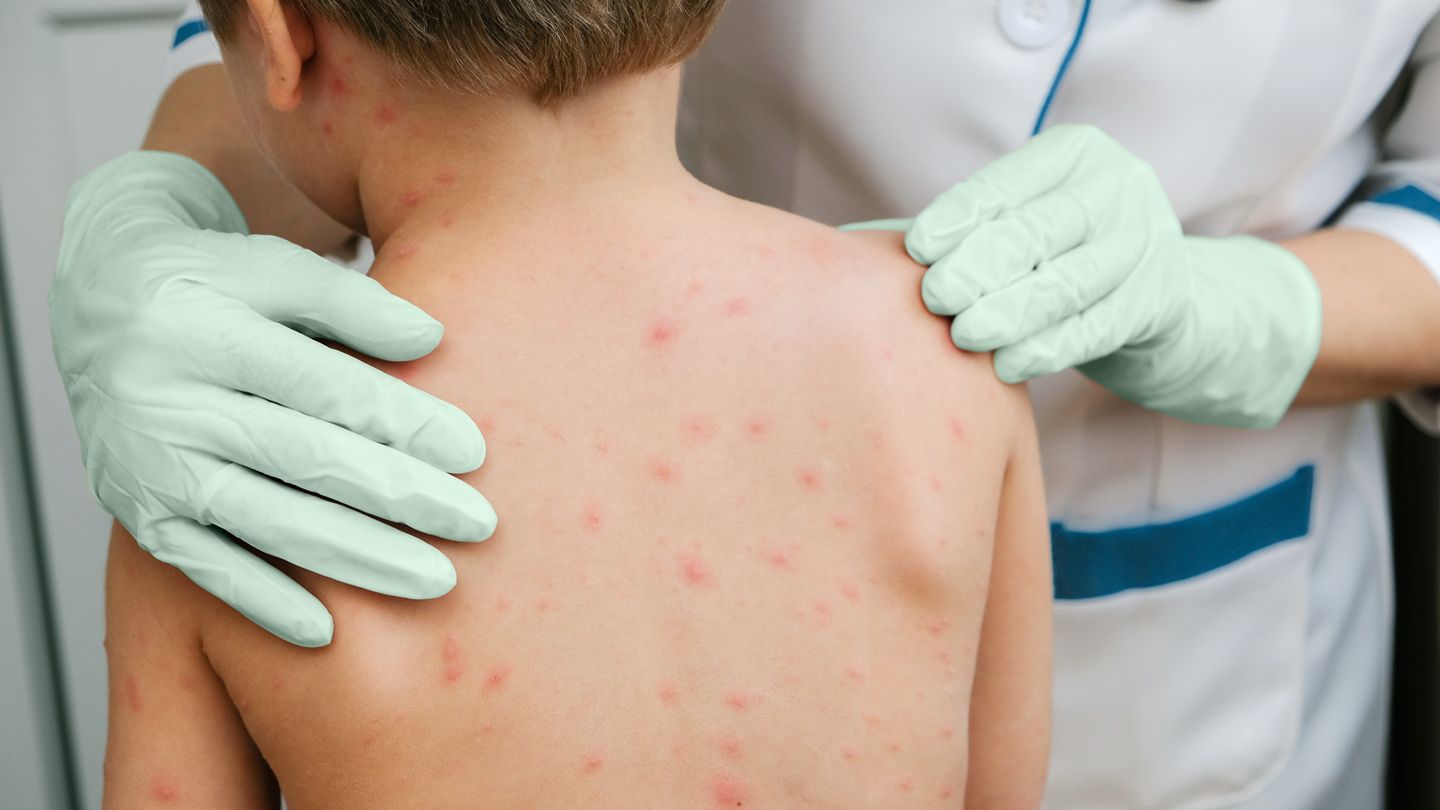Understanding the difference between viral skin rashes is key to effectively treating and preventing symptoms. Here are some of the most common viral rashes, what they look like, and who’s most at risk.
Measles
Measles (also known as rubeola) is a highly contagious virus that causes symptoms like high fever, cough, runny nose, red or white spots in your mouth, and a rash. The rash typically starts on the face, especially near the hairline, and works its way down the body.
“The measles rash looks like blotchy red or violet patches that can be flat or raised with a bumpy texture. It can merge as the rash spreads,” says Geeta Yadav, MD, a board-certified dermatologist in Toronto. “Tiny white spots can appear on top of these patches and may also appear in the mouth.”
Anyone can get the measles, but nearly all unvaccinated people will catch the virus if exposed. You’re also more likely to experience complications — which can include pneumonia, brain swelling, blindness, or even death — if you’re pregnant, have a weakened immune system (those with HIV/AIDS, taking chemotherapy, or recovering from surgery), or are younger than 5 years or older than 20.
Rubella
Rubella (also known as German measles) is another highly contagious virus that can cause a skin rash, along with symptoms like low fever, cough, joint pain, runny nose, and pink eye. The rash looks like pink or red spots that typically start on your face — often near the hairline or behind the ears — before spreading down your body, says Dr. Yadav.
It’s possible for anyone to get rubella, but nearly every unvaccinated person exposed to the virus will get it. If you get rubella during pregnancy, it’s also possible that your baby will develop congenital rubella syndrome, a rare but potentially severe condition that can cause developmental issues.
Roseola
Roseola is a common viral skin rash in babies. It’s contagious and caused by human herpesvirus 6, which affects nearly all infants and young children before they turn 2. Though rare, it’s possible for older children or adults to get it, too.
Roseola causes a sudden high fever followed by a rash of flat or raised pink and light red spots. The rash often starts on the torso before spreading to the rest of the body, says Yadav.
Chicken Pox (Varicella Zoster)
Chicken pox is a contagious infection caused by the varicella-zoster virus. It’s a common viral rash in children, though it can also occur in unvaccinated adults.
“There are three phases to the chicken pox rash,” says Yadav. “Initially, it’s red and bumpy, then after a few days, the bumps turn into fluid-filled blisters. A few days after that, the blisters scab over.” Chicken pox typically appears on the face or trunk before spreading across the body, and it’s very itchy the entire time.
Shingles (Herpes Zoster)
Shingles is an infection caused by the reactivation of the chicken pox virus. Anyone who has had chicken pox is susceptible to shingles, though it’s most common in people age 50 or older, especially those who haven’t been vaccinated. Your risk increases with age, which is why you usually see this viral rash in older adults.
“The shingles rash is a raised rash on one side of the body, typically on the face or trunk,” says Yadav. But the rash can be more widespread (similar to a chicken pox rash) in people with weakened immune systems. “The area is typically very painful, itchy, and tingly before the rash appears. After a few days, the rash will turn into a blister, which will break and then scab over,” Yadav notes.
Fifth Disease
Fifth disease, also known as erythema infectiosum, is a common viral rash caused by parvovirus B19. It primarily strikes during spring and early summer months and affects kids between 5 and 15 years old, though adults can also get infected.
The condition starts with symptoms like fever, vomiting, and diarrhea, followed by its characteristic “slapped-cheek” rash — a bright red, raised, and itchy rash on the cheeks, says Yadav. Some people also develop a second rash on the torso or buttocks that has a “lacy” appearance.
Hand, Foot, and Mouth Disease
Hand, foot, and mouth disease is a common condition typically caused by coxsackievirus 16. It usually infects children, though adults can get it too, says Gary Goldenberg, MD, a board-certified dermatologist in New York City.
“This rash usually causes small red spots or blisters on hands, feet, and the insides of the mouth. The mouth sores can be very painful,” he says. The virus also causes fever, sore throat, and fatigue.
Molluscum Contagiosum
Molluscum contagiosum (also called water warts) is a viral skin infection caused by a virus of the same name. It’s most common in children, and causes flesh-colored, dome-shaped bumps with a central dimple that can be painful or irritating, says Dr. Goldenberg.
These pimple-like bumps can appear anywhere on the body, but are most common on the face, torso, and limbs. It’s also possible for adults to sexually transmit the virus, which can cause bumps on or around the genitals, Goldenberg says.
“While the bumps may resolve on their own, it can take approximately one and a half years,” he says.
Herpes Simplex Virus
Herpes is a highly contagious condition caused by the herpes simplex virus type 1 and 2 (HSV-1 and HSV-2). It can infect different parts of the body — like the mouth, genitals, or eyes — and spreads through skin-to-skin contact with the infected area. Anyone can get it, and once you’re infected, the virus stays in your body forever (though it often remains dormant).
A herpes rash is painful red, fluid-filled blisters or sores, typically on lips (HSV-1) or genitals (HSV-2), says Goldenberg. The herpes virus can also cause fever and swollen lymph glands.




